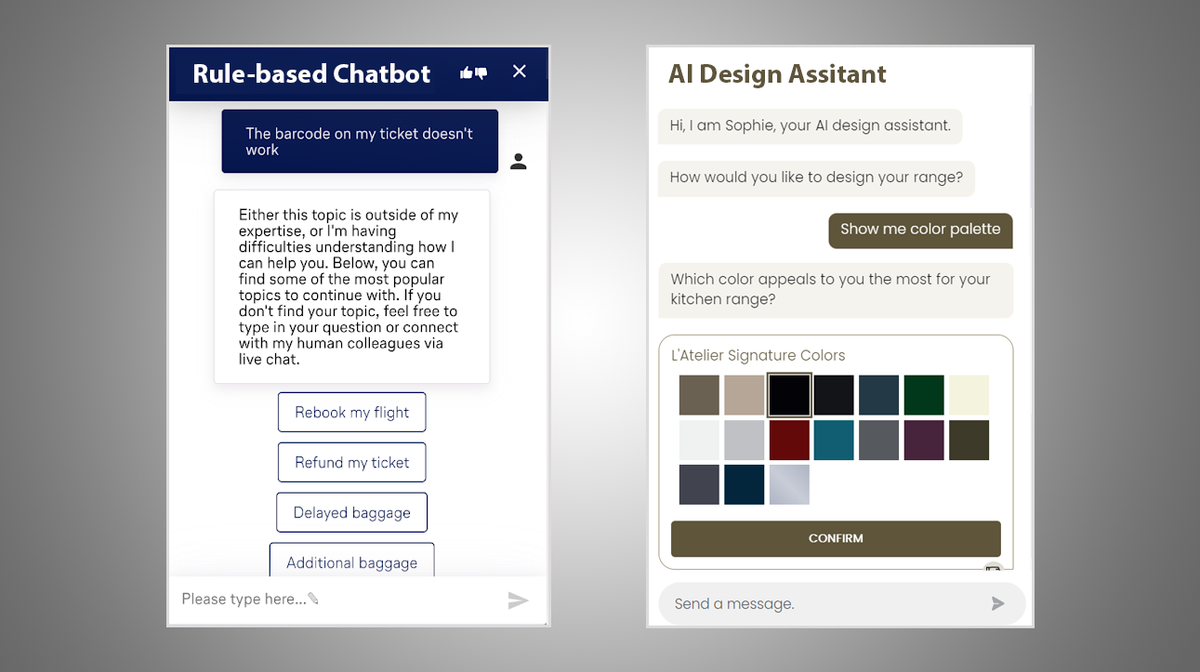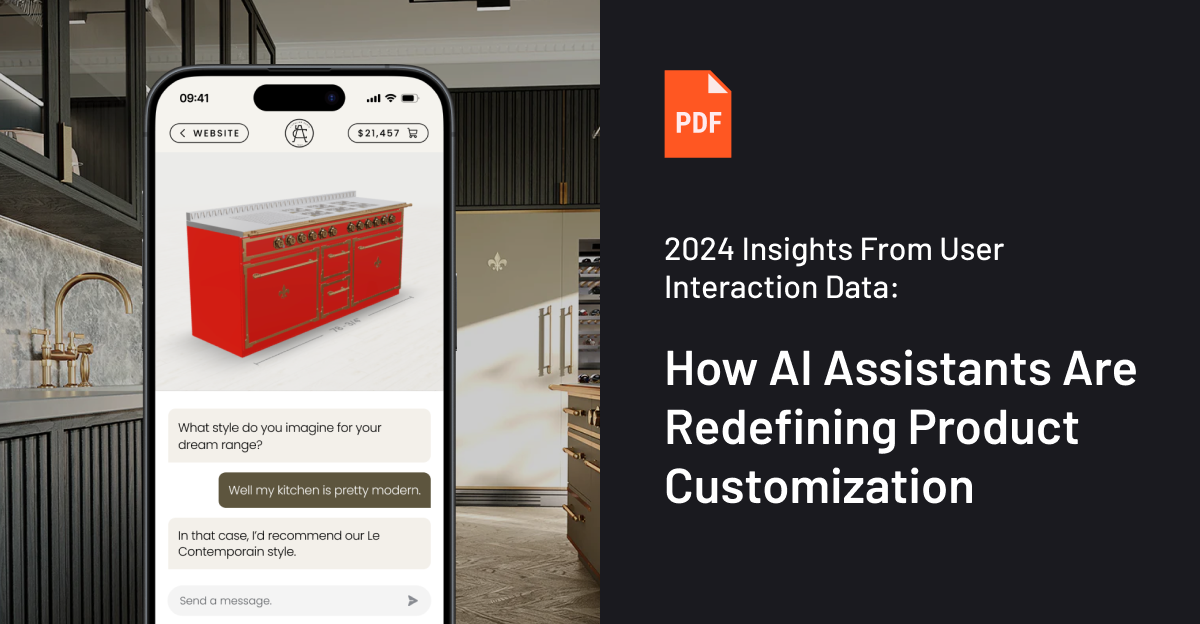A Complete Guide to Conversational AI in E-Commerce: Everything You Need to Know
If your e-commerce is stagnating and you want to enhance customer satisfaction and engagement, Conversational AI might be the key. Discover how it can reshape your strategy, offering a more personalized and intuitive shopping experience to keep your customers engaged and satisfied.

As e-commerce grows, so do customer expectations. Shoppers want quick, personalized experiences, and Conversational AI is transforming how businesses can deliver just that. This technology, capable of understanding and responding to human language, is revolutionizing the shopping experience—from answering questions to guiding product customization.
Is your e-commerce experience stagnating? Are you exploring ways to enhance customer satisfaction and engagement? Here’s everything you need to know about conversational AI and how it can reshape your e-commerce strategy.
What Is Conversational AI?
You’ve probably heard the term "Conversational AI" tossed around, but you might not be exactly sure what it means. Simply put, it’s the technology behind the AI assistants you interact with online. It’s a form of artificial intelligence that understands, processes, and responds to human language in a way that feels natural.
Using Machine Learning (ML) and Natural Language Processing (NLP), conversational AI can handle both spoken and written language, mimicking human conversations and answering questions in multiple languages. It’s widely used in customer service to provide personalized responses quickly and efficiently. In fact, the conversational AI market is expected to grow from $4.8 billion in 2020 to $18.4 billion by 2026, as more companies adopt it to enhance customer support and automate interactions.
The Benefits of Conversational AI
In e-commerce, conversational AI can help in many ways, such as giving personalized product recommendations, making product customization easy, offering quick customer support, and helping customers compare products to make better choices. In all these cases, conversational AI will bring significant benefits:
- Lower support costs: AI can handle customer questions, reducing the need for large support teams, all while keeping service quick and enjoyable.
- More conversions: With personalized recommendations and guidance, customers are more likely to complete their purchases.
- Quicker decisions: By getting answers and product comparisons right away, customers can decide faster, making the shopping process smoother.
- Scalability: AI can manage tons of customer interactions and customer inquiries at once, allowing businesses to grow without losing the personal touch or slowing down service.
Conversational AI vs. Chatbots: What’s the Difference?
You might think that Conversational AI and AI assistants are just fancy names for another frustrating chatbot that responds with "Let me pass you to a human," but it's not! Traditional chatbots rely on pre-set scripts, which means they can only handle simple, straightforward questions. Anything beyond that, and they get stuck, leaving users annoyed.

Conversational AI, on the other hand, is much smarter. It uses natural language processing and machine learning to understand more complex questions and respond naturally. Instead of just following a script, it adapts and learns from each interaction, making conversations more fluid and human-like, while handling tougher queries with ease.
How Conversational AI Works
Conversational AI uses natural language processing (NLP) to understand what users want and track key details like names or preferences. It remembers past conversations to make interactions feel smooth and connected. This helps create a faster, more user-friendly experience. Each chat feels seamless, even as the conversation evolves.
Additionally, conversational AI constantly improves by learning from previous interactions. With every conversation, it gets better at understanding user needs and responding effectively. Over time, this leads to more personalized, accurate, and human-like interactions that meet the user's needs more efficiently.

Why You Should Implement Conversational AI
Conversational AI is quickly becoming a key part of the shopping experience as technology improves and shoppers grow more familiar with it. To be an early adopter, it’s worth exploring how Conversational AI can benefit your website. The global Conversational AI market, valued at $5.78 billion in 2020, is expected to grow to $32.62 billion by 2030, with a 20% annual growth rate.

Looking at improvements in Conversational AI, ChatGPT quickly became one of the fastest-growing apps in history, reaching 100 million users in just two months after its launch in 2022. This rapid growth sparked competition among tech giants like Microsoft and Google, leading them to speed up advancements in AI. Microsoft integrated AI into its products with OpenAI's help, while Google accelerated work on its own AI tools, like Bard.
Meanwhile, online shoppers have already embraced conversational AI and expect it in their shopping experience. 71% of consumers expect companies to deliver personalized interactions, with 83% willing to share personal data to facilitate more personalized experiences. On top of that, 76% are open to AI assistants answering their questions.
Conversational AI, Generative AI, Conversational UI: What’s the Difference?
You’ve likely heard of Conversational AI, Generative AI, and Conversational UI without fully grasping their differences. While they share some underlying technology, they serve different purposes. Conversational AI helps systems understand and respond to human language naturally.
Generative AI, however, focuses on creating new content—whether it’s text, images, or music—by learning from patterns in data. It’s used for everything from content creation to data generation.
Conversational UI, on its side, refers to the user interface that allows users to interact with systems through natural language, whether via text or voice. It turns traditional button-based interfaces into conversations, making the interaction more intuitive and user-friendly.

Use Cases of Conversational AI in E-Commerce
Conversational AI is most commonly used in e-commerce for customer support. With a 24/7 virtual assistant, customers get instant answers without waiting in line, ensuring quick and seamless service at any time. A great example is Salesforce's Einstein, which goes beyond basic chatbots by using machine learning and natural language processing.
It understands context, provides personalized responses, and predicts customer needs. For instance, Einstein can help a client optimize their sales pipeline by analyzing past data, offering tailored suggestions, and automating tasks—acting more like a smart assistant than a simple chatbot.
While using Conversational AI for customer support is practical, it's already widespread and no longer groundbreaking. But what about applying it to product customization? That’s where things get exciting. Picture this: you want to customize a ring for a gift to your wife. Instead of staring at the options not knowing what to choose, you can just ask the AI assistant what stone and color would fit best if your wife likes classic or elegant styles. You can also ask the AI assistant to engrave a message on the ring, and see the results in real-time.
This is an example of a Conversational Configurator, developed by Salsita—the first and only on the market. Instead of manually selecting features, customers can ask for help, receive recommendations, or let the AI assistant customize the product for them in real-time. Paired with 3D models, this offers a seamless and engaging way to personalize products.

Challenges of Conversational AI in E-Commerce
Conversational AI is revolutionizing e-commerce, and like any transformative technology, it faces several challenges. A key issue is data privacy and security. As AI systems handle increasing volumes of personal and transactional data, concerns about data breaches and misuse grow. According to a Pew Research study, 79% of Americans are worried about how companies use their data. This underscores the importance of compliance with privacy regulations like GDPR and CCPA to maintain consumer trust.
In 2023, data quality problems affected 31% of business revenue, up from 26% the year before. Additionally, 70% of companies struggling with data trust say poor data quality is the main issue. If the data isn’t accurate or up-to-date, AI systems can’t make the right recommendations or give a smooth customer experience. To avoid this issue, businesses should use tools that help keep their data accurate, clean, and up-to-date so AI can work smoothly and make better recommendations.
The Future of Conversational AI in E-Commerce: What’s Next?
The future of conversational AI in e-commerce is about more than just better AI assistants—it’s heading towards AI systems that will fundamentally change how businesses interact with customers. One emerging trend is multimodal AI, which will combine text, voice, images, and even video for more immersive, human-like conversations.
Imagine shopping online where an AI assistant can not only chat with you but also visually guide you through product options or even demonstrate features in real-time through video. The global multimodal AI market is expected to grow at a compound annual growth rate (CAGR) of 36.2%, reaching $10.55 billion by 2031.
Another exciting development is emotionally intelligent AI. Today’s Conversational AI systems can already detect external emotional cues, like frustration in a customer’s tone, and respond with phrases like, “I’m sorry, I apologize if I misunderstood.” However, the future of emotionally intelligent AI will go far beyond this. Advanced systems will be able to interpret deeper, more complex emotions using physiological and vocal biomarkers, enabling them to respond in a truly empathetic manner. They’ll adapt to not only what customers say but how they feel, leading to more meaningful and supportive interactions.
Final Thoughts
Conversational AI is more than a trend—it's becoming essential for e-commerce businesses that want to stay competitive. From enhancing customer support to personalizing shopping experiences, this technology helps streamline operations and meet growing consumer demands for speed and personalization. However, to fully unlock its potential, the industry must tackle challenges like data quality and privacy concerns.
If you're looking to take the next step and enhance your product customization, Salsita provides a fresh approach. With our Conversational Configurator, we combine natural conversation with 3D product customization, creating a seamless, intuitive experience for your customers. It’s a smart way to stay ahead in the rapidly evolving e-commerce landscape.
Curious about how a Conversational Configurator can transform your customer experience and drive sales?
Schedule a demo and we’ll walk you through it:




